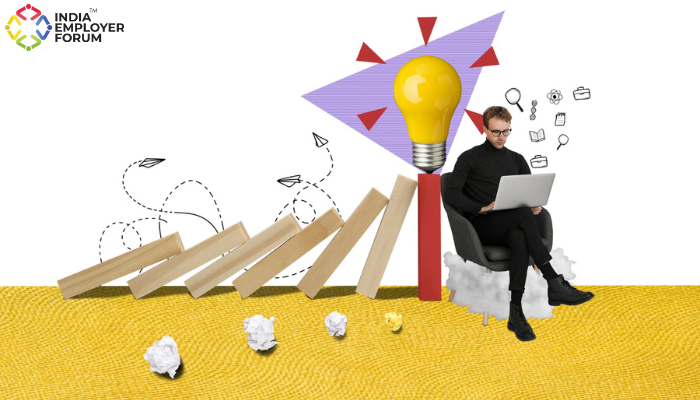In the 21st century, one of the fundamental purposes of leadership and management is to prepare the business for long term strength and agility. The goal is not to navigate through the challenges as they come, but be prepared for it proactively. The economy is transforming rapidly with enormous amount of changes in the technological, socio-political and economic environment. Employers and workers are feeling immense pressure to adapt to this transformation, which is leading to greater concerns about exhaustion and burnout.
To deal with this dynamic business environment, organizations need to build and adapt resilient strategies for their leader and employees. However, most companies in India still use the old hierarchical management practices that is not in touch with the needs of the present business scenario. They do not have a clear understanding of what organizational resilience means and how to build an operational resilience framework.
Organizational resilience is the ability of an organization to foresee and prepare for the incremental changes and sudden interruptions that a dynamic business environment poses. It encourages businesses to look beyond risk management and have a holistic view of business health. An organization with business resilience has a proactive approach, dynamic leadership, greater responsiveness to change, a strong corporate culture, and a long-term vision.
Resilience is a capability that can be adopted by the organizations as well as individuals. Individual resilience can be cultivated through mindfulness training among many other measures but it is equally important to have a business resiliency process that demonstrates an organization wide commitment and is imbibed into the leadership culture.
You might also be interested to read: Effective Learning Programs to Build High Performing Teams
Shaping organizational resilience from the top
It is crucial for the leaders to model the behavior that they expect out of the employees. They must build strong relationships and create a strong support system for the teams. This connection must be constant and not during a crisis alone. Organizations that demonstrate innovation and business resilience dedicate time to encourage learning. They emphasize on helping the employees debrief what they have accomplished and plan their next steps. Also, leaders must be able to accept failures and mistakes, and have faith that their team is working hard and build operational resilience in the business processes.
Beyond employee wellness
While some organizations are now taking steps towards employee wellbeing and providing free fitness classes, mindfulness courses and nutrition education, it is still not the norm. Also, these steps while often necessary for the mental and physical health of the workforce, are not sufficient as far as building business resilience is concerned. There has to be a continuous and integrated initiative to build resilience at workplace, and these efforts must be proactive and practical.
Habit formation
Building organizational resilience should become an important part of the conversation at workplace and more awareness needs to be created. The employees must be encouraged to identify and commit to personal strategies to build resilience and personalize it as far as possible. It must be integrated into everyday practices and build slowly to form long lasting habits.
Compelling vision
A resilient organization needs to have a compelling vision not just for the impending changes, but also the higher purpose for the existence of the organization, the purpose behind their work and how that purpose connects everyone in the organization. It calls for removing slower moving hierarchical structures and replace it with an ecosystem of empowered teams with leaders at all levels along with the resources and autonomy to make decisions and function in a decentralized manner. This will help in creating operational resilience throughout the organization.
Talent acquisition strategy
A talent acquisition strategy that is aligned with the vision of the organization doesn’t only ensure culture fit for the new recruits but also encourages a healthy diversity in the teams. Resilient organizations encourage workforce diversity. People with different thinking styles yet similar values and goals, help in gathering unique insights and different ways of looking at a problem. This makes the teams more effective and thus enhances operational resilience.
Continuous learning
To build organizational resilience, it is important to invest in the personal and professional growth of employees by designing a learning culture and thus, improving the rate of retention for the best talent. More significantly, the focus of the development must go beyond subject matter expertise and invest in emotional intelligence, behavioral skills and leadership development irrespective of the title or position. Focused resilience training on an individual basis will go a long way in building an organizational culture where the employees are not afraid of changes, risks and ambiguity. Any organization that strives to build a resilient work culture must use the entire HR cycle of hiring, developing, engaging, retraining and retaining to create business resiliency.
Flexible working
Flexible job structures alleviate employee stress. They feel that they have some control over their work conditions and can manage stress better. A workforce that is tired and stressed cannot help in creating organizational resilience. While young organizations have started adopting flexible working, for most Indian organizations it is still a source of anxiety. It can only happen when the management shows more trust towards its employees and avoid micromanaging.
Collaboration
Resilient organizations are highly supportive of collaborations and hence believes in cross- functional teams that can work towards common organizational goals and innovate further. While they have a customer-centric approach, their team is also a major priority. Feedback from within and outside the organization helps them develop actionable insights that they can execute swiftly, thus creating operational resilience.
Looking forward
High performing and resilient teams, are skilled to perform well in this ever-changing business environment. They are trained to see what is coming ahead and will have a futuristic thinking mindset. They manage to keep one eye on the present and another in the future, which helps them look at future opportunities while keeping their situational awareness intact. This helps them create a business resiliency process to create a balance between present and future goals.While organizational resilience might sound like the next buzz word, it is needed more than ever due to the huge amount of changes in the business environment. If an organization wants to stay relevant and competitive, adapt to the emerging technologies and be able to manage the multi-generational workforces, they need to discover new ways to imbibe operational and business resilience into the organizational culture.
References:
- How to Build Organizational Resilience- Alan Todd, 10 June, 2019
- How Leaders Build the Resilient Organizations of Tomorrow: A Navy SEAL’s Perspective- Brent Gleeson, 17 August, 2017
- 5 Ways to Build a Resilient Organization- Dorie Clark, 28 February, 2013
- Organisational Resilience- Natavan Aliveya, 19 June, 2018




